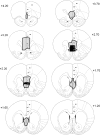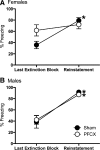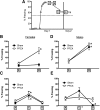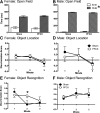Prefrontal cortex lesions and sex differences in fear extinction and perseveration
- PMID: 20445082
- PMCID: PMC2862409
- DOI: 10.1101/lm.1778010
Prefrontal cortex lesions and sex differences in fear extinction and perseveration
Abstract
Electrolytic lesions of the medial prefrontal cortex (PFCX) were examined using fear conditioning to assess the recall of fear extinction and performance in the Y-maze, open field, and object location/recognition in male and female Sprague-Dawley rats. Rats were conditioned to seven tone/footshocks, followed by extinction after 1-h and 24-h delays, revealing PFCX effects and sex differences during all phases of fear conditioning. In male rats, PFCX impaired 24-h recall of fear extinction to tone, which required the 1-h delay extinction and was not attributed to nonassociative factors. In contrast, sham and PFCX females increased freezing to tone following a 24-h delay, whether or not 1-h delay tone extinction was presented. Moreover, PFCX females failed to extinguish to tone, contrasting to the robust extinction to tone that was observed for sham females, PFCX, and sham males. Also, sex differences were found during acquisition, with sham females acquiring fear conditioning slower than PFCX females. By the last tone-shock presentation, sham and PFCX females showed a slight but significant reduction in freezing to tone relative to those of sham and PFCX males. Of the other behavioral measures, PFCX females maintained exploration of a novel object during object recognition when sham females habituated. PFCX did not influence other behaviors in the remaining tasks. These findings show important sex differences in PFC function, with the PFC influencing the recall of fear extinction in males and contributing to the acquisition and maintenance of fear extinction memory in females, perhaps through altering perseveration.
Figures








Similar articles
-
Chronic stress and sex differences on the recall of fear conditioning and extinction.Neurobiol Learn Mem. 2009 Mar;91(3):323-32. doi: 10.1016/j.nlm.2008.11.005. Epub 2009 Jan 6. Neurobiol Learn Mem. 2009. PMID: 19073269 Free PMC article.
-
The role of ventromedial prefrontal cortex in the recovery of extinguished fear.J Neurosci. 2000 Aug 15;20(16):6225-31. doi: 10.1523/JNEUROSCI.20-16-06225.2000. J Neurosci. 2000. PMID: 10934272 Free PMC article.
-
Dynamic expression of FKBP5 in the medial prefrontal cortex regulates resiliency to conditioned fear.Learn Mem. 2017 Mar 15;24(4):145-152. doi: 10.1101/lm.043000.116. Print 2017 Apr. Learn Mem. 2017. PMID: 28298552 Free PMC article.
-
Prefrontal mechanisms in extinction of conditioned fear.Biol Psychiatry. 2006 Aug 15;60(4):337-43. doi: 10.1016/j.biopsych.2006.03.010. Epub 2006 May 19. Biol Psychiatry. 2006. PMID: 16712801 Review.
-
Sex differences in fear extinction.Neurosci Biobehav Rev. 2019 Aug;103:81-108. doi: 10.1016/j.neubiorev.2019.05.020. Epub 2019 May 23. Neurosci Biobehav Rev. 2019. PMID: 31129235 Free PMC article. Review.
Cited by
-
The neurobiological basis of sex differences in learned fear and its inhibition.Eur J Neurosci. 2020 Jul;52(1):2466-2486. doi: 10.1111/ejn.14602. Epub 2019 Nov 7. Eur J Neurosci. 2020. PMID: 31631413 Free PMC article. Review.
-
Individual Differences in Conditioned Fear and Extinction in Female Rats.Front Behav Neurosci. 2021 Aug 18;15:740313. doi: 10.3389/fnbeh.2021.740313. eCollection 2021. Front Behav Neurosci. 2021. PMID: 34489657 Free PMC article.
-
Sex differences and chronic stress effects on the neural circuitry underlying fear conditioning and extinction.Physiol Behav. 2013 Oct 2;122:208-15. doi: 10.1016/j.physbeh.2013.04.002. Epub 2013 Apr 23. Physiol Behav. 2013. PMID: 23624153 Free PMC article. Review.
-
Generation of a whole-brain hemodynamic response function and sex-specific differences in cerebral processing of mechano-sensation in mice detected by BOLD fMRI.Front Neurosci. 2023 Aug 28;17:1187328. doi: 10.3389/fnins.2023.1187328. eCollection 2023. Front Neurosci. 2023. PMID: 37700753 Free PMC article.
-
Fear-Conditioning to Unpredictable Threats Reveals Sex and Strain Differences in Rat Fear-Potentiated Startle (FPS).Neuroscience. 2023 Oct 15;530:108-132. doi: 10.1016/j.neuroscience.2023.08.030. Epub 2023 Aug 26. Neuroscience. 2023. PMID: 37640137 Free PMC article.
References
-
- Beck KD, Luine VN 2002. Sex differences in behavioral and neurochemical profiles after chronic stress: Role of housing conditions. Physiol Behav 75: 661–673 - PubMed
-
- Berry B, McMahan R, Gallagher M 1997. Spatial learning and memory at defined points of the estrous cycle: Effects on performance of a hippocampal-dependent task. Behav Neurosci 111: 267–274 - PubMed
-
- Blanchard RJ, Blanchard DC 1969. Crouching as an index of fear. J Comp Physiol Psychol 67: 370–375 - PubMed
Publication types
MeSH terms
Grants and funding
LinkOut - more resources
Full Text Sources
Miscellaneous
